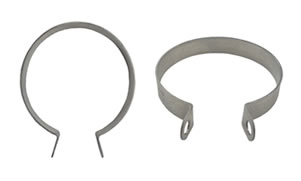
Loop clamps are commonly used to secure hoses around fittings. They consist of a single, solid piece of metal that’s shaped like a loop. At the base of a loop clamp is a pair of prongs. To install a loop clamp, you can pull the prongs apart. Doing so will make the loop clamp wider so that you can fit it over the hose and fitting. Releasing the prongs will then force it to contract back to its original size, thus applying pressure to the hose and fitting — just like a spring. There are several things you should consider, however, when choosing loop clamps.
Durable Material
While they all feature the same basic design with a loop shape and a pair of notches, loop clamps are available in different materials. For maximum protection against leaks, you should choose loop clamps made of a durable material.
Some of them are made of stainless steel. Stainless steel loop clamps are strong, long-lasting, and they offer excellent resistance to corrosion. Other loop clamps are made of aluminum. Aluminum is a lightweight and strong material. And like stainless steel, it also offers excellent resistance to corrosion.
Tongue Hole Type
What type of tongue hole does the loop clamp feature? When inspecting the notches at the base of a loop clamp, you may notice they have small holes. Known as tongue holes, they support fasteners.
Most loop clamps feature round tongue holes. The holes in the notches are round, meaning you can use them with traditional fasteners. The round tongue holes may be threaded or unthreaded. Running fasteners through the round tongue holes will reinforce the loop clamp so that it doesn’t fall off the hose with which it’s used.
The Size
Loop clamps are available in a wide range of sizes. The size, of course, will determine the hoses with which they can be used. If a loop clamp is too big, it may fit loosely, in which case the hose won’t be secured to the fitting. If a loop clamp is too small, you may not be able to fit it around the hose or fitting.+
Surface Treatment
Something else to consider when choosing loop clamps is the surface treatment. As the name suggests, it’s the type of treatment or finish used on the surface of a loop clamp.
Some loop clamps feature an anodized surface treatment. Anodization is an electrolytic finishing process. It’s used to create a protective layer of oxide on the surface of a metal object. Other loop clamps feature a cadmium surface treatment. They may feature a stainless steel or aluminum construction. On the surface, though, is a thin layer of cadmium.



